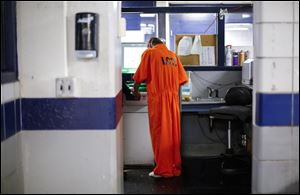
Lucas County criminal justice reform aims even higher
6/6/2018
An inmate is finger printed at the Lucas County Jail. Lucas County was awarded $1.75 million from the John D. and Catherine T. MacArthur Foundation to implement reforms and programs aimed at reducing its jail population.
After nearly two years of ambitious criminal justice reform efforts, Lucas County has achieved remarkable success.
Fewer people are going to jail, fewer people are skipping their court appearances, and fewer people are getting arrested for new crimes while awaiting trial on a charge.
RELATED: Lucas County praised for justice reform work
The efforts of a coalition of local elected leaders, judges, law enforcement, and other officials has made Lucas County a standout among the communities participating in the John D. and Catherine T. MacArthur Safety and Justice Challenge.
“Lucas County is clearly one of our high performers,” MacArthur Foundation Justice Reform Director Laurie Garduque told The Blade’s editorial board during a recent visit to Toledo.
The county is expected to apply soon for renewed funding for two more years in the project. And those next two years promise to be an even bigger challenge than the previous two because local authorities and MacArthur officials agree that the next step in reducing jail population and reforming criminal justice locally will mean focusing on the racial and ethnic disparities that systematically plague criminal justice.
That’s not a Lucas County problem. That’s an American problem.
A Pew Research Center report in 2016 showed that African-Americans, who make up about 12 percent of the U.S. population, made up about 33 percent of the country’s prison population.
African-Americans are overrepresented at every step in the Lucas County criminal justice process. While black people make up not quite 20 percent of the county’s population, they represent 58 percent of people arrested, 49 percent of people charged, 45 percent of people convicted, and 48 percent of people sentenced to prison in Lucas County.
Rooting out systemic bias and eliminating that disparity will be no small task. If it were easy, law enforcement, courts, and prison systems would have done it decades ago.
This will require fundamental rethinking of many of the processes that funnel people from Lucas County communities through the criminal justice system and into courtrooms and jail cells. It will demand confronting deeply uncomfortable truths about the injustices that pervade much of our justice system.
Click here to view more Blade editorials
But the coalition that has led criminal justice reform for the last few years has been able to achieve all that it has so far by doing the hard work of building cooperative relationships, mining and using data to drive decisions, and being willing to rethink the way police, courts, probation departments, and jails do almost everything they do. They will have to draw on those successes to dive deeper in the next two years.
The legitimacy of a community’s criminal justice system rests on its ability to be transparent and truly just to everyone. If it cannot be that, then the system is broken. If the criminal justice reform cannot achieve that, then it will have failed.